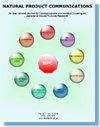The Enhanced Anti-anxiety Potentiality and Relevant Material Basis for the Extracts of Bile Processed Coptidis Rhizoma
IF 1.4
4区 医学
Q4 CHEMISTRY, MEDICINAL
引用次数: 0
Abstract
ObjectiveBile-processed Coptidis Rhizoma (CR) exhibits stronger cold properties and central effect. However, the commonly used bile includes pig/cattle/sheep bile. It is currently unclear which kind of bile performs the best synergistic effect, and the enhanced efficacy is mainly contributed by what components. In this work, a comparative study on pig/cattle/sheep bile processed CR (pCR/cCR/sCR) was carried out.Materials and MethodsFirstly, the anxiety model of sthenic heat type was established. Then, pharmacological research involving general state observation, biochemical examination (succinate dehydrogenase, glucokinase, corticosterone, adrenocor ticotropic hormore), pathological evaluation (liver and hippocampus tissue), and behavioral tests (elevated plus maze, open field test) was implemented. Finally, chemical assessment involving high-performance liquid chromatography (HPLC) fingerprints of pCR/cCR/sCR extracts and mass spectrograms of pig/cattle/sheep bile were performed in combination.ResultscCR performed the most prominent enhancement in improving hyperactive energy metabolism in liver and abnormal hyperactivity of hypothalamic–pituitary–adrenal axis axis. As for chemical assessment, HPLC fingerprints of pCR/cCR/sCR extracts indicated that alkaloid components detected in cCR extracts were relatively low, mass spectrograms of pig/cattle/sheep bile suggested that bile acids in cattle bile were relatively abundant, and the contents of taurocholic acid, glycocholic acid, and glycodeoxycholic acid were particularly high.ConclusionCattle bile could be specified as the processing excipient for bile-processed CR, and the high levels of taurocholic acid, glycocholic acid, and glycodeoxycholic acid mainly contributed to the enhanced efficacy of cCR.胆汁加工的黄连提取物的抗焦虑增效作用及相关物质基础
目的经胆汁加工的黄连(CR)具有更强的寒性和中枢效应。然而,常用的胆汁包括猪/牛/羊胆汁。目前还不清楚哪种胆汁的协同效果最好,也不清楚疗效的增强主要是由哪些成分促成的。本研究对猪/牛/羊胆汁加工 CR(pCR/cCR/sCR)进行了比较研究。然后,进行药理学研究,包括一般状态观察、生化检查(琥珀酸脱氢酶、葡萄糖激酶、皮质酮、促肾上腺皮质激素)、病理学评估(肝脏和海马组织)和行为测试(高架加迷宫、开阔地测试)。最后,结合 pCR/cCR/sCR 提取物的高效液相色谱(HPLC)指纹图谱和猪/牛/羊胆汁质谱图进行了化学评估。在化学评估方面,pCR/cCR/sCR 提取物的高效液相色谱指纹图谱显示,cCR 提取物中生物碱成分的检出率相对较低;猪/牛/羊胆汁的质谱图显示,牛胆汁中胆汁酸的含量相对较高,尤其是牛胆酸、甘胆酸和甘去氧胆酸的含量较高。结论牛胆汁可作为胆汁加工 CR 的加工辅料,而牛胆汁酸、甘氨胆酸和甘去氧胆酸的高含量是提高 cCR 疗效的主要原因。
本文章由计算机程序翻译,如有差异,请以英文原文为准。
求助全文
约1分钟内获得全文
求助全文
来源期刊

Natural Product Communications
工程技术-食品科技
CiteScore
3.10
自引率
11.10%
发文量
254
审稿时长
2.7 months
期刊介绍:
Natural Product Communications is a peer reviewed, open access journal studying all aspects of natural products, including isolation, characterization, spectroscopic properties, biological activities, synthesis, structure-activity, biotransformation, biosynthesis, tissue culture and fermentation. It covers the full breadth of chemistry, biochemistry, biotechnology, pharmacology, and chemical ecology of natural products.
Natural Product Communications is a peer reviewed, open access journal studying all aspects of natural products, including isolation, characterization, spectroscopic properties, biological activities, synthesis, structure-activity, biotransformation, biosynthesis, tissue culture and fermentation. It covers the full breadth of chemistry, biochemistry, biotechnology, pharmacology, and chemical ecology of natural products.
Natural Product Communications is a peer reviewed, open access journal studying all aspects of natural products, including isolation, characterization, spectroscopic properties, biological activities, synthesis, structure-activity, biotransformation, biosynthesis, tissue culture and fermentation. It covers the full breadth of chemistry, biochemistry, biotechnology, pharmacology, and chemical ecology of natural products.
 求助内容:
求助内容: 应助结果提醒方式:
应助结果提醒方式:


